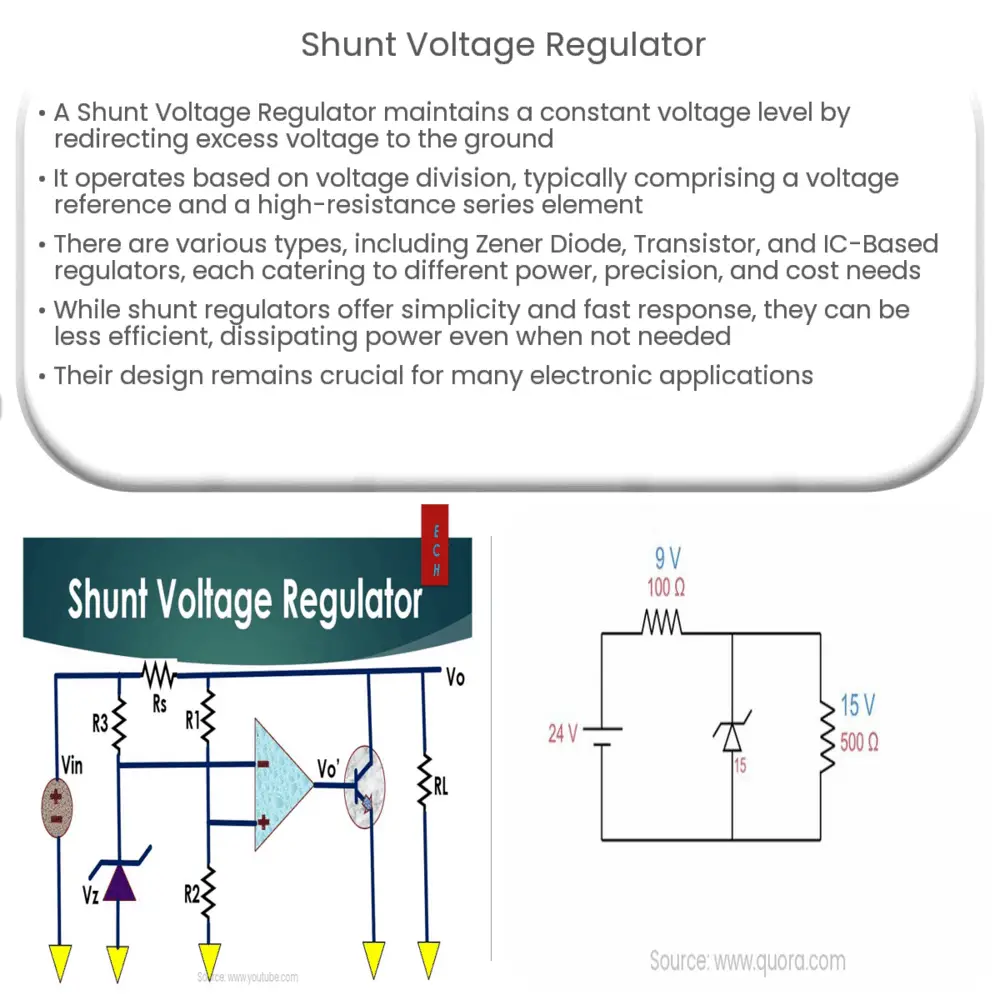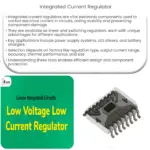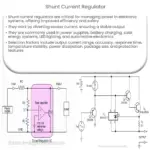Explore the workings, types, advantages, and design considerations of shunt voltage regulators in this comprehensive guide.

Introduction to Shunt Voltage Regulator
A Shunt Voltage Regulator is a vital component in electrical and electronic circuits, designed to maintain a constant voltage level. It achieves this by shunting (redirecting) any excess voltage to the ground, hence the name ‘shunt regulator’. This device is crucial in preventing the potential damage that could be caused by voltage fluctuations or surges within a circuit.
Working Principle of a Shunt Voltage Regulator
The basic operation of a shunt voltage regulator revolves around the concept of voltage division. It is typically composed of two elements: a voltage reference and a high-resistance series element. The voltage reference could be a Zener diode or any other device capable of maintaining a constant voltage across itself. The series element, usually a resistor, is connected in parallel with the voltage reference.
When input voltage increases beyond the desired level, the excess voltage is diverted through the voltage reference, thus maintaining a constant output voltage. Conversely, if the input voltage drops below the desired level, the voltage reference reduces its current, allowing more voltage to pass to the output. This dynamic adjustment keeps the output voltage stable, regardless of changes in the input voltage or load current.
Types of Shunt Voltage Regulators
- Zener Diode Voltage Regulator: This is the most common type of shunt voltage regulator. The Zener diode is used as the voltage reference. When the voltage across the diode exceeds its Zener voltage, it starts conducting in the reverse direction, shunting the excess voltage to ground.
- Transistor Shunt Voltage Regulator: In this type, a bipolar junction transistor (BJT) is used instead of a Zener diode. The BJT has a greater power handling capability, making this type of shunt regulator suitable for applications requiring higher current outputs.
- IC-Based Shunt Voltage Regulator: Integrated circuit (IC) based shunt voltage regulators use a voltage reference and an op-amp. These regulators offer improved accuracy, stability, and power handling capability compared to Zener diode and transistor-based regulators.
These different types of shunt regulators cater to varying requirements of power, precision, and cost, providing flexible options to suit different applications.
Applications of Shunt Voltage Regulators
Shunt voltage regulators find use in a wide array of applications due to their simplicity and effectiveness. They are extensively used in power supplies, battery chargers, and voltage reference circuits. Their ability to clamp voltage to a specific level also makes them useful in protection circuits, such as overvoltage protection and electrostatic discharge protection.
Advantages and Disadvantages of Shunt Voltage Regulators
Shunt voltage regulators have certain inherent advantages. Their primary benefit is their simplicity, both in terms of design and operation. This simplicity leads to lower costs, making them an attractive choice for many applications. Shunt regulators are also known for their fast response time to voltage fluctuations, providing immediate voltage regulation.
However, these regulators also have some disadvantages. The most significant one is their relatively low efficiency. Since they work by shunting excess voltage to ground, they consume power even when the load does not require it. This power dissipation can lead to thermal issues, particularly in high-power applications. Moreover, they have a limited power handling capability due to the physical constraints of the shunt element, typically a Zener diode or transistor.
Design Considerations for Shunt Voltage Regulators
When designing a circuit with a shunt voltage regulator, several key considerations come into play. The choice of regulator type (Zener, transistor, or IC) depends on the application requirements, such as power level, precision, and cost. The power dissipation capacity of the regulator should also be considered to ensure that the regulator can handle the maximum load current without overheating. Additionally, the source impedance should be appropriately selected to allow the regulator to maintain a constant output voltage despite changes in the input voltage or load current.
Conclusion
In conclusion, shunt voltage regulators are indispensable components in electronic and electrical circuits. Their primary function is to maintain a stable voltage level, providing protection against potential damage caused by voltage fluctuations. Despite certain limitations such as power dissipation and limited power handling capacity, their simplicity, cost-effectiveness, and fast response time make them a widely used solution in many applications. As technology continues to evolve, the design and capabilities of shunt voltage regulators are expected to improve, making them even more integral to the future of electronics and electrical engineering.




